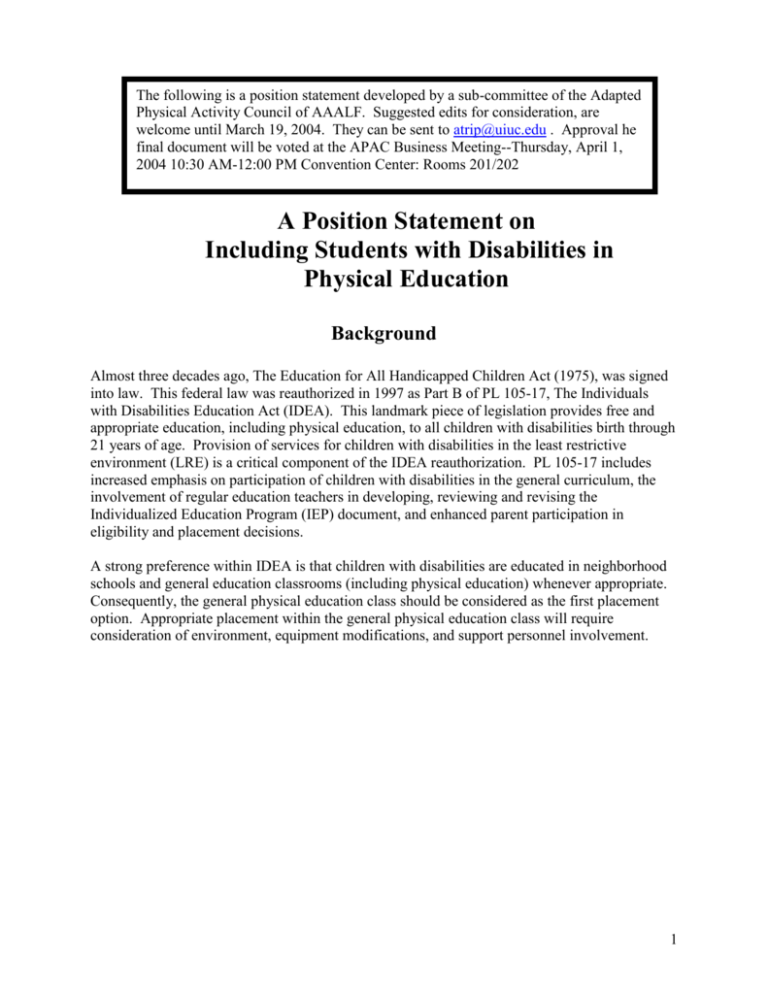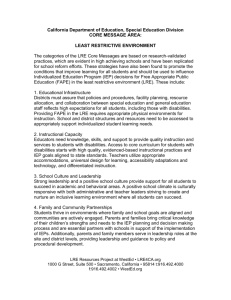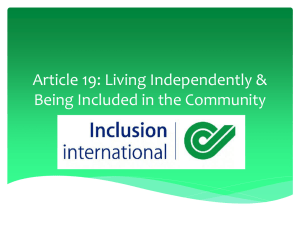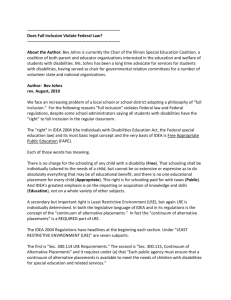A strong preference within IDEA is that children with disabilities be
advertisement

The following is a position statement developed by a sub-committee of the Adapted Physical Activity Council of AAALF. Suggested edits for consideration, are welcome until March 19, 2004. They can be sent to atrip@uiuc.edu . Approval he final document will be voted at the APAC Business Meeting--Thursday, April 1, 2004 10:30 AM-12:00 PM Convention Center: Rooms 201/202 A Position Statement on Including Students with Disabilities in Physical Education Background Almost three decades ago, The Education for All Handicapped Children Act (1975), was signed into law. This federal law was reauthorized in 1997 as Part B of PL 105-17, The Individuals with Disabilities Education Act (IDEA). This landmark piece of legislation provides free and appropriate education, including physical education, to all children with disabilities birth through 21 years of age. Provision of services for children with disabilities in the least restrictive environment (LRE) is a critical component of the IDEA reauthorization. PL 105-17 includes increased emphasis on participation of children with disabilities in the general curriculum, the involvement of regular education teachers in developing, reviewing and revising the Individualized Education Program (IEP) document, and enhanced parent participation in eligibility and placement decisions. A strong preference within IDEA is that children with disabilities are educated in neighborhood schools and general education classrooms (including physical education) whenever appropriate. Consequently, the general physical education class should be considered as the first placement option. Appropriate placement within the general physical education class will require consideration of environment, equipment modifications, and support personnel involvement. 1 Personnel Components of Inclusion Model General Physical Education Environment Equipment Components of Inclusion Model Inclusion in the general physical education program should be considered and determined on an individual basis so that the child with a disability can: -achieve goals and objectives stated on the IEP -participate and demonstrate learning in the general education setting -demonstrate competency in state and district-wide physical fitness or skills assessment or alternative tests to match the child's unique needs Inclusion is not about getting students with disabilities out of separate adapted physical education classes; any more than it is about getting students with disabilities into general physical education classes. Rather, it is about students being members of a learning community where they have the choice of the most appropriate instructional setting, equal access, dignity, and the opportunity to participate in meaningful physical activity. Least Restrictive Environment (LRE) means that to the maximum extent possible, each child with a disability must be educated with children who are not disabled unless the nature or severity of the disability is such that education in the general environment with the use of supplementary aids and services cannot be achieved satisfactorily. Language regarding LRE is found in the IDEA amendments of 1997, Section 1412(a)(5)(A), and Section 300.550(b)(1)(2) of Title 34 of the Code of Federal Regulations. 2 The following chart shows some examples of environmental, personnel, and equipment modifications that could assist children with disabilities to be successful in the general education program. LRE SETTINGS APE SERVICES Environment Personnel GPE no support needed general general GPE with support Curriculum Modifications and/or Instructional Modifications Equipment general GPE = General Physical Education Combination GPE + Separate APE Variable and will change depending on curriculum and instructional modifications needed Separate APE Small group or individual APE Specialist Peers Aides Physical Therapists Occupational Therapists Special Educators Administrators Nurses/Doctors Communitybased professionals size texture weight color function technology APE = Adapted Physical Education LRE Setting AND APE Services Model Specific considerations that teachers have identified as concerns or possible barriers to providing quality instruction in the LRE include: Class size Ratio of students with disabilities to those without Type and severity of disability Available support personnel These are important considerations but should never be used to exclude a student from the GPE program. These considerations should be discussed at the IEP team meeting and modified whenever possible so that the student with a disability can be successful in the GPE program. 3 Position on Inclusion and Physical Education The following statements represent the position of the American Alliance for Health, Physical Education, Recreation, and Dance (AAHPERD) on the inclusion of children with disabilities in physical education: Students with disabilities must be included to the maximum extent possible in the general physical education program. Students with disabilities in general physical education will have the opportunity to learn and perform in the physical, cognitive, and social-emotional domains. Students with disabilities must be actively engaged participants in meaningful learning experiences in the general physical education class, not just in the physical proximity or space. Students with disabilities must not be removed from or placed into the general physical education program except through the IEP team decision-making process. (Ultimately, it is the school’s responsibility to justify why the student cannot be educated in a general physical education setting.) The extent that students with disabilities are included in the general physical education program must be determined through the IEP team decision-making process. Decisions involving the inclusion of students with disabilities into the general physical education program must consider the safety of ALL students, including the students with disabilities. Often, safety concerns can be addressed with supplementary aids and supports, and such supplements should be tired before removing the child due to safety concerns. The inclusion of students with disabilities into the general physical education program must not compromise the learning of other students in the class. Often, learning concerns can be addressed with supplementary aids and supports, and such supplements should be tired before removing the child due to learning concerns. Families must be meaningfully involved in the IEP team decision-making process related to the inclusion of their child in the general physical education program. Students with disabilities in the general physical education program must receive regular evaluation of progress toward IEP goals as often as same age peers receive evaluation feedback such as report cards. Supplementary aides and services, as well as other instructional support (as needed) will be provided in the general physical education environment to students with disabilities and/or the physical educator. General physical educators will receive direct and/ or consultative services from qualified professionals in adapted physical education (APE) to support the inclusion of students with disabilities when needed. The voice of students with disabilities will be heard and they will participate in the IEP team decision-making process to the maximum extent possible. 4 Frequently Asked Questions How does inclusion relate to General Physical Education and LRE? Children with disabilities have the right to be meaningfully engaged in learning in the GPE. Quality physical education programs account for individual differences in all students and are accountable for the seven goals of a physically educated person developed by NASPE (1995). This being the case, general physical education that is both individualized and meets NASPE's comprehensive set of content standards will quite often be the LRE for students with disabilities. When students with disabilities are able to receive quality instruction in the general physical education class this is referred to as "inclusion." How are inclusion and LRE different? LRE is a mandate of IDEA and requires that to the maximum extent possible students with disabilities are educated with students without disabilities in the general physical education program. LRE is a continuum of environments where instruction takes place and services are provided as needed. LRE has many options for instructional environments from inclusion to separate APE services Inclusion is a philosophy of acceptance that supports placing students with disabilities in their neighborhood schools. Supplementary aids and services, or other supports are brought to the student while in the general physical education class rather than having the student go to these services in a separate class. Should I have an APE class set up in my school for students who need it? APE is a service not a setting. This is a very important distinction. You must ensure that all students with disabilities that need APE services receive this service in order to benefit from quality instruction in physical education in the LRE, which is the setting. Look at the APE Services and LRE Setting Model on page-3 of this booklet. All those involved in an IEP team meeting, including you, must consider the most appropriate APE services and LRE setting for each child on a case by case basis. Some students might benefit from a combination of GPE and a separate APE class, in which case having this setting available is important. Flexibility in your schedule is key here and this is something that is important to discuss with your school administrator. Show him or her this document; many administrators are not aware how IDEA impacts physical education. Who is a “qualified” professional in APE? The definition of “qualified” is determined by each state. Unlike other special education areas (i.e., teachers, speech therapist, etc.) most states do not have a special or unique certification for teachers of adapted physical education. The Adapted Physical Education National Standards (APENS) have been put in place in order to define the minimal competencies teachers need to deliver appropriate physical education services to students with disabilities. For more information see the APENS website at www.cortland.edu/APENS/ or contact AAHPERD at 800-213-7193 x430. 5 When should a general physical educator be involved in the IEP team decision-making process? Any time a student with a disability is not learning and cannot be successful in the GPE. Being a member of the IEP team requires that the general physical educator be involved in assessment, instructional recommendations, program implementation strategies, determination of instructional goals and objectives, and ongoing evaluation. Collaboration with other professionals is essential to making the IEP process work. If the general physical educator is not knowledgeable of the IEP process this would be a good time to seek out the assistance of an APE specialist or consultant or contact your state chapter of AAHPERD or AAHPERD directly at 800-213-7193 x430. Does a general physical educator need to write an IEP for a student who is included in his or her physical education class? Yes. All teachers must be accountable for their instructional program; learning is the primary focus of physical education and it is important that ALL students are learning. Physical educators must plan and prepare an IEP for a student with a disability that is included in the general education program to ensure that the student is working toward his or her individualized goals. Progress toward these goals must be evaluated on the same schedule as report cards. Physical educators should ask for support from an APE specialist when necessary, because meeting the challenges of inclusion requires additional preparation, training, and courage to try new things. Has anybody asked the students how they feel about being included in general physical education? Yes. When students with disabilities were asked what is a good day in physical education (Goodwin & Watkinson, 2000) they said…. “I feel like I belong, because my peers cheer me on or the teachers say I am doing a good job; I share in receiving the benefits from participation,” because I am learning and improving my skills; and I have confidence in my skills, I like my peers to see that I am doing well in physical education.” When asked what is a bad day in physical education students with disabilities said…. “I feel like my participation is restricted, my classmates don’t pass the ball to me and the teachers don’t let me play; my abilities are questioned, my peers think I can’t do it; I feel socially isolated and rejected; I lose my autonomy and feel like I have no control over what happens to me or the outcomes." Physical educators can learn from listening to what students with disabilities say about their needs and experiences. This information can then be used to modify the general physical education environment, equipment, and personnel. Where do I start? If you already run a program that accounts for individual differences in your students without disabilities and meets the National Standards for Physical Education (1995) developed by NASPE, then it will not be a big step to include students who have disabilities. The Components of Inclusion Model on page-2 identifies three key areas physical education teachers should 6 consider when developing a program of inclusion in general physical education; environment, equipment and personnel. Environment: Inclusion means everyone belongs in a school that is a "community" of learners. A positive learning environment invites all students to participate in meaningful learning that offers a variety of opportunities for personal successes. Attention to the social environment is important to the success of inclusion. Teachers must closely monitor the social environment to protect all students from ridicule, exclusion or discrimination. Environmental adaptations can include both Curriculum modifications (what is taught) as well as Instructional modifications (how it is taught). Possible places to start include: Using small group instructional approaches such as stations, centers, contracts, task cards, or agendas. Measuring success in a variety of ways such as journals, portfolios, interest surveys, skill inventories, and/or class discussion. Incorporating cooperative games, team building activities, and/or individual goal setting, while avoiding elimination type activities. Deemphasize tradition type team sport approaches and instead focus on skill themes, health-related fitness, and/or adventure education. Move away from the 3 to 4 week multi-activity units and instead extend practice time in skill theme areas or skills for an active lifestyle. Offer multiple ways to demonstrate personal competence based on individualized goals determined at the beginning of a unit, theme, or activity. Change the game design by modifying one or several of the components; purpose, players, movements, objects, organization, and/or limits (Morris & Stiehl, 1999). Equipment: Be creative by increasing a variety of equipment (including adapted or assistive devices) as well as multiple pieces of equipment. Equipment selection will vary per activity, student, facility, surface, and purpose. Consider changes in size, texture, weight, color, and function of equipment, as well as electronic or technological devices that will enhance learning. Examples include: A very large and light ball instead of a traditional volleyball to change the pace of the game. Balls with sound to assist in tracking. Velcro or other strapping devices to enhance grip on a racquet or bat. Heart rate monitors to ensure safe heart rate zones and provide concrete feedback. Computer technology to provide additional information, a greater variety of visual demonstrations, or to repeat instructions. Personnel Collaboration with others is key to making inclusion work. General physical educators should develop a community of support that can facilitate the inclusion process. Support personnel could include: APE Specialists Peers Aides Physical Therapists Occupational Therapists Special Educators 7 Administrators Community-based professionals (i.e., Recreation, Fitness, Rehabilitation) Nurses/Doctors/Health Care Professionals University Faculty How do I know when inclusion is working? Inclusion is a complex issue that is interpreted differently by different people. "Inclusion" is not just being together in the same "space," but all children engaging in meaningful activities together, sharing equal status, and learning together. Inclusion is a "process" and there is no exact measure of success. However, one way to evaluate how your program is "working" for all students is to use these principles of inclusion as indicators: Social Justice: All people have equal value and each person has a right to an equal share of the services and materials available. Equal Opportunity: All people have the right to be treated equally, to have choices and to take risks. No person should be discriminated against; neither should rules or conditions exist that make it more difficult for some people to participate than others. Non-categorization: People are individuals with many things in common and some things different. There is no such thing as a "category" of people that are all the same. Non-segregation: People need contact with a variety of people; this helps us all understand about various ways of life and allows us to make choices with greater awareness. What resources are out there on inclusion in physical education? Books: Strategies for Inclusion: A Handbook for Physical Educators (2002). By Lauren Lieberman and Cathy Houston-Wilson. Human Kinetics: Champaign, IL. www.humankinetics.com Inclusion Through Sports (2002). By Ronald Davis. Human Kinetics: Champaign, IL. www.humankinetics.com A Teachers Guide to Including Students with Disabilities in General Physical Education (2nd Edition) (2000). By Martin Block. Paul H. Brookes: Baltimore, MD www.brookespublishing.com Morris, G. S. D. & Stiehl, J.(1999). Changing Kids' Games, 2nd edition. Human Kinetics: Champaign, IL. www.humankinetics.com Hichwa, J. (1998). Right Fielders are People Too: An Inclusive Approach to Teaching Middle School Physical Education. Champaign, IL: Human Kinetics. www.humankinetics.com Games for People with Sensory Impairments: Strategies for Including Individuals of all Ages (1996). By Lauren Liberman and Jim Cowart. Human Kinetics: Champaign, IL. www.humankinetics.com 8 Inclusive Games (1995). By Susan Kasser. Human Kinetics: Champaign, IL. www.humankinetics.com Web sites: American Alliance for Health, Physical Education, Recreation, and Dance: National Association for Sport and Physical Education and the Adapted Physical Activity Council (through the American Association for Active Lifestyles and Fitness) can be located here. http://www.aahperd.org PE Central: Lots of lesson plan ideas. www.pecentral.org Physical Education for Infants, Children, and Youth with Disabilities: A Position Statement (2003) www.aahperd.org/aaalf/pdf_files/pos_papers/apa_positionpaper.pdf Project INSPIRE: Information about disability, inclusion and links to many other sources of information. www7.twu.edu/~f_huettig/ The National Center on Physical Activity and Disability: Latest information on physical activity and specific disabling conditions. www.ncpad.org/ Equipment: Flaghouse: Special Populations Equipment Catalog www.flaghouse.com Sportime: Abilitations- Adapted Equipment Catalog www.sportime.com References: Federal Register, March 12, 1999m PL 105-17, IDEA 1997. Goodwin, D.L., & Watkinson, E.J. (2000). Inclusive Physical Education from the Perspective of Students with Physical Disabilities. Adapted Physical Activity Quarterly, 17, 144-160. Morris, G. S. D. & Stiehl, J.(1999). Changing Kids' Games, 2nd edition. Champaign, IL: Human Kinetics National Association for Sport and Physical Education (1995). Moving Into The Future: National Standards for Physical Education. Boston: WCB McGraw-Hill. 9






